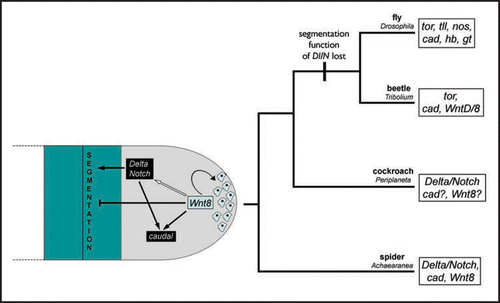Figures & data
Figure 1 Model of the ancestral regulatory network for posterior development in arthropods and its evolution in insects and spiders. The left-hand illustration, at the base of the tree, shows the possible regulatory network of Wnt8, Delta-Notch (Dl/N) and caudal (cad) in a schematic, generalized growth zone of the hypothetical ancestral arthropod. The last two segments (blue highlighted area) and the unsegmented growth zone (grey highlighted area) are shown with the posterior to the right. Dashed lines indicate more anterior segments. Wnt8 is thought to establish and maintain a pool of undifferentiated cells at the very posterior of the growth zone (curved arrow pointing to the cells in blue) and may block segmentation (blunt arrow). At the same time, Wnt8 may be responsible for the dynamic expression of Delta and Notch because it initiates the clearance of expression of these genes from the very posterior of the growth zone (white arrow), which is needed for the correct induction of the segmentation process. Wnt8 and the Delta-Notch signaling may also be directly or indirectly responsible for the regulation of cad (black arrows). While Delta and Notch play an important role in the segmentation mechanism in spiders and insects like the cockroach, the function of these genes in segmentation may have been lost in the lineage leading to other insects like flies and possibly beetles (indicated by the vertical bar at the branch to beetles and flies).
